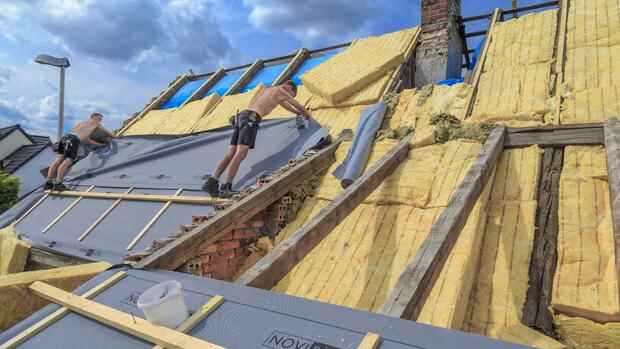Brussels, Berlin You are one of the greatest culprits in the climate, but also an area with considerable potential for social divide: buildings. There are up to 240 million properties in the EU. To heat and cool them, Europeans use 40 percent of their total energy needs. 36 percent of the greenhouse gases emitted within the Union are caused by this sector.
It is therefore clear that if the EU wants to achieve its climate goals, according to which emissions should fall by 55 percent by 2030 compared to 1990, real estate must become more energy-efficient. The Commission’s approach is therefore: renovate, renovate, renovate. “About 75 percent of the current building stock is energetically inefficient,” writes the Brussels authority in a new draft law. The paper is available to the Handelsblatt. It will be officially presented this Wednesday.
“85 to 95 percent of the buildings that exist today will still be standing in 2050,” the commission states. If the renovation continued at the current pace, it would take several centuries for all properties to be energetically converted.
The commission wants to help with a number of measures and at the same time has to be careful that the housing costs do not rise to astronomical heights because of the renovations. Therefore, plenty of funding should flow: for example from the regional funds, from the “Fund for the Just Transition”, which was set up to finance a socially acceptable energy transition, and from the Corona reconstruction aid. Private money should also be mobilized.
Top jobs of the day
Find the best jobs now and
be notified by email.
The main proposals from the Commission are:
1. Improve energy efficiency
The Commission calls for certain minimum energy standards to be implemented during renovations, which will apply to all old buildings from 2035 onwards. The member states can decide which minimum standards to prescribe, as long as they help to make the building sector climate-neutral by 2050.
However, new buildings must be “energy self-sufficient” by 2030, public buildings even earlier, old buildings by 2050 at the latest. Energy self-sufficient means that buildings are so energy-efficient that very little energy is required on site from renewable sources such as Solar roofs, self-generated.
The EU Commission relies primarily on “deep renovation”: it describes renovations that involve 30 percent energy savings. Member States should support this with financial aid and a low bureaucratic effort. At the same time, Brussels has strict requirements: Buildings that do not meet the criteria for energy class E from January 2027 (and from January 2033 for class C) should disappear from the market: They are then no longer allowed to be sold or rented.
“Renovations are the key to reducing the energy consumption of buildings, lowering emissions and also lowering energy costs”, writes the Commission – and promotes its approach: renovations create jobs and growth.
2. Sustainable building material
The process of building should also be taken into account when reducing emissions. Because so-called embedded emissions make up around ten percent of emissions in the building sector worldwide. In future, they are to be taken into account in the energy certificates of buildings.
In order to reduce emissions, the Commission is focusing on “resource efficiency and the circular economy”. In addition, more sustainable building materials should be used, for example wood.
3. Depletion of fossil energy sources
Two thirds of the energy consumption of buildings comes from fossil fuels, above all oil and gas. Member States should now ensure that buildings are used without fossil fuels and that no more subsidies are granted for the construction of oil or gas heating systems by 2027 at the latest. “All new buildings should be emission-free and existing buildings should be converted without emissions by 2050”, emphasizes the Commission in this part of the directive.
4. Charging stations for e-cars
In order to also promote emission-free mobility, at least one charging point for e-cars is to be installed in houses outside of residential buildings. In every conventional parking lot, the necessary cables should already be laid in order to be able to build a charging point there later. In addition, a bicycle parking space is to be set up for every car parking space.
“The bottom line is that the Commission’s proposal can be described as a balanced mix of pricing, targets and support measures,” says Ismail Ertug, a European politician from the SPD. However, it must be ensured that the renovation costs do not hang on the tenants alone.
The umbrella association of the German housing industry GdW, on the other hand, is criticizing: The EU directive is a “step backwards”, according to GdW President Axel Gedaschko. Because it “does not take into account the good neighborhood approaches, as they are also contained in the coalition agreement and in the resolutions of the conference of building ministers”. Instead, “the individual, isolated building is brought into focus” in the guideline.
The associations still have the opportunity to make their voices heard: the Commission’s proposal has yet to be approved by Parliament and the Member States.
More: Here homeowners have a lot of catching up to do in terms of climate protection

